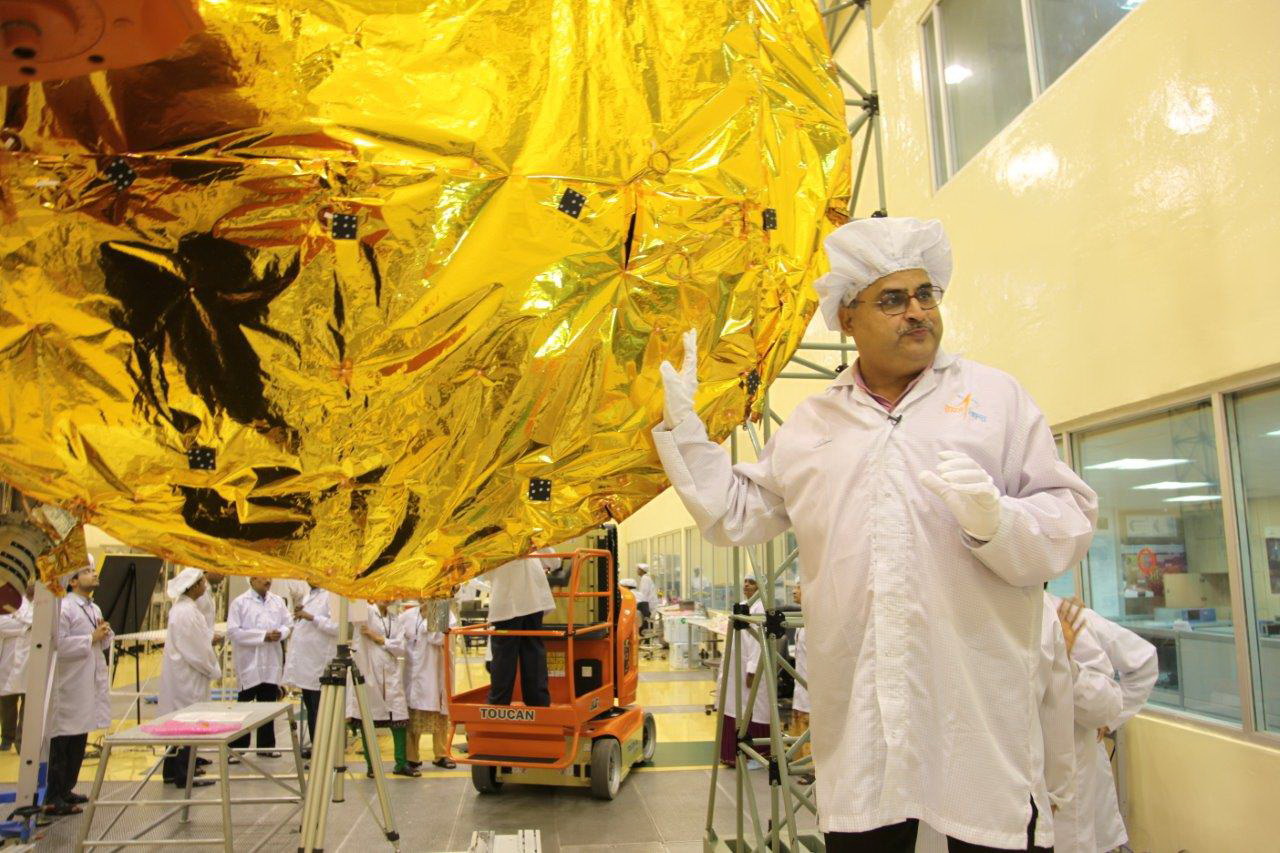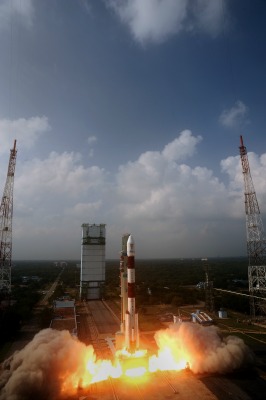
“The Hollywood movie Gravity cost more than our Mars Mission – this is a great achievement.” – Prime Minister Narendra Modi
“The Earth, Moon and Mars are part of one industrial complex.” – President APJ Abdul Kalam
India created global history by becoming the first nation in the world to have successfully reached the orbit of Mars in the very first attempt. India’s Mars Orbiter Mission or Mangalyaan reached its destination Mars after a 300-day marathon covering over 670 million kilometres and with precision made its entry into the Martian orbit. Savouring this moment of pride in the Mission Control Centre were women wearing lovely silk sarees and were called the 'super MOM’s’ who literally hugged each other after the mission was declared successful.
I have followed every twist and turn of this mission and for me personally it was a joyous moment as outside ISRO, I am told, I am the only one whose fingerprints are on the Mangalyaan and today my finger prints have reached more than 210 million kilometres away orbiting the Red Planet. The smiles and handshakes and the hurrays that were part of the celebration was truly unique, since in the many launches I have covered at ISRO never has the mood been so electric.
The book 'Reaching for the Stars: India’s Journey to Mars and Beyond’ published by Bloomsbury is the untold story of India’s marathon to Mars, from the Red Fort in Delhi to the Red planet, a special journey to test technological capability and explore the allure of Martian mysteries. It is also a geo-political dash to beat regional rival China in this 21st century Asian Space Race. “We have done a lot, but yeh dil maange more”. This evocative challenge, meaning, “this heart desires more”, was posed by India’s Prime Minister, Narendra Modi, for scientists and engineers whom he addressed at India’s rocket port in Sriharikota in southern India.
India’s relentless appetite for space faring led it to mount its first-ever interplanetary mission to the Earth’s neighbour Mars. The Mars Orbiter Mission (MOM) or Mangalyaan began a treacherous journey of 670 million kilometres on November 5, 2013. Inter-planetary journeys naturally traverse uncharted territories, inspiring the human mind. This is the story of a scintillating 15-month roller-coaster ride during which India’s Martian dreamers made the country proud, by giving the world its cheapest inter-planetary probe.
If this is not reaching for the stars, what is? This is an exclusive, insider’s narrative from a person whose fingerprints are literally on the tiny, Tata Nano car-sized Mars Orbiter Satellite. Using good old Indian jugaad, or more from less, and end-to-end frugal engineering, the Indian Space Research Organisation (ISRO) pulled off the Mars mission in unique Indian style, going alone into deep space. Space technology is at its sparkling best here, replete with accounts of scientists sleeping in their laboratories to clock the endless hours that were necessary to complete a tough job in time.
Hundreds of spectacular photos, many never seen before images from deep inside the Indian space agency and stirring human-interest stories of missionary zeal reveal the major dimensions of the mission that was almost written-off even before it lifted off.
In the 21st century, exploring Mars with the ultimate aim of colonising it is certainly the next big thing worldwide, for nations to stake their claim on the rich resources of a planetary neighbour that seems to hold several promises for humanity, or to simply find answers to the tantalising and eternal question ‘are we alone in the universe’. That, in essence, is what defines the future of space exploration for the world, and India is very much in that big league. This book celebrates that never-say-die attitude of Indians, as the country charts new frontiers in space exploration.

Pallava Bagla up close and personal to the Mangalyaan in 2013 when it was being developed inside ISRO satellite center in Bangalore.
Back in Bangalore, the usually sombre engineers and scientists of the Indian Space Research Organisation at its Mission Control Centre, which is shaped like a flying saucer, erupted into a thunderous applause when the first data arrived on their screen at about 8 am India telling them that India’s Mars Orbiter Mission (MOM) had successfully been captured in an orbit around Mars. Cheering the scientists from the front was none other than India’s Prime Minister Narendra Modi. A space buff, he flew into Bangalore to personally be part of this historic moment. He came in wearing a red jacket probably signifying the Red planet.
In his stirring speech after the success, Modi said 'Mars and Mom have been united’ and he asked Indians to join in the celebration suggesting that when India wins a cricket tournament the country erupts in joy. He said the 'silent saints of science who work behind closed doors away from media and public also need to be applauded’ with an applause five times more loud.

India’s Mangalyaan was launched on a balmy afternoon on November 5, 2013 and it is today at $67 million the cheapest inter-planetary mission ever to be undertaken. In his inimitable style Modi said 'it was a great achievement since it has cost less than the production cost of Hollywood blockbuster movie Gravity’ which had cost about $100 million to make. Today, M Annadurai, the program director for Mangalyaan satellite is a happy and proud satellite engineer as the images taken by the satellite are being recognised as being rare celestial beauties.
Lauding India in its achievement is the global community. NASA Administrator Charles Bolden in a statement calls it 'an impressive engineering feat, and we welcome India to the family of nations studying another facet of the Red Planet.’
For the larger community of India, a bigger and silent joy is that India beat its big brother and Asian bully China in reaching Mars. China has a much more robust space program but in the sprint to reach mars on this long 300-day marathon, the Indian elephant has outperformed the Red Dragon and reached pole position at least in this Asian space race to Mars.
The 1350-kilogram satellite is now in its 6-month life studying the thin atmosphere of Mars and trying to unravel alongside America’s MAVEN mission, as to why and how Mars lost its water and atmosphere. MOM will also look for signatures of the presence methane gas which if present could indicate the presence of carbon based life. A highly elated former chairman of ISRO UR Rao describes the mission as 120% successful so far in its 'dream run’.
Zee Jaipur Literature Festival will host a session: India’s Space Odyssey
A conversation between authors of the book `Reaching for the Stars: India’s Journey to Mars and Beyond’ Pallava Bagla & Subhadra Menon and iconic ISRO satellite engineer Dr M. Annadurai the man who made both Chandrayaan-1 and Mangalyaan a reality.
Date: Saturday, January 24, 2015
Time: 2.15 to 3.15 PM
Venue: British Airways Baithak, Diggi Palace, Jaipur.
About the Authors
Pallava Bagla is a globally acclaimed science communicator and photographer who, in a career spanning more than a quarter century, has seen from very close quarters the blossoming of the Indian Space Research Organisation (ISRO). His insightful command of India’s secretive nuclear, missile, and space programmes is unparalleled. In 2014, Pallava was conferred a national award for excellence in journalism by the Prime Minister of India. Pallava works for the Science magazine and New Delhi Television. He can be reached at pallava.bagla@gmail.com
He tweets @pallavabagla
Subhadra Menon is an award-winning writer and much sought-after public speaker with several books to her credit. Over the years, she has acquired deep insights into many of India’s major developmental programmes, particularly those related to science and society, and the health system. She works with the Public Health Foundation of India in New Delhi, where she is Professor, Health Communication. She can be reached at subhadra.menon@gmail.com.
Text Copyright - Pallava Bagla & Subhadra Menon, 2015.
You can order book from:
http://www.amazon.in/Reaching-Stars-Indias-Journey-Mars-Beyond/dp/9384052329
http://www.flipkart.com/reaching-stars-indias-journey-mars-beyond-english